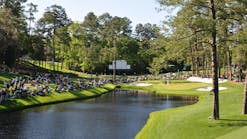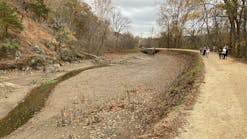Problems with the current fecal indicator bacteria (FIB) have led to the situation where some stormwater discharges are meeting water quality bacteria criteria at the discharge point, but are leading to instream violations of the criteria below the discharge point. New stormwater discharges are pushing reservoirs of bacteria from forested wetlands into downstream receiving waters.
This leads to the interesting situation where stormwater discharges are the “cause” but not the “source” (load) of the bacteria causing the violation. This was not envisioned in the Clean Water Act (CWA) and is different than the normal cause and source assessment.
The Environmental Protection Agency (EPA), as part of its responsibilities, periodically issues technical guidance, and its latest guidance on Recreation Criteria came out in 2012. While it still recommended the previous FIB of E. coli and Enterococci, it noted that epidemiological studies seemed to indicate that most illnesses were probably viral. It also noted that indicator bacteria were endemic to subtropical and temperate waters. It further stated that studies show proliferation of the indicator bacteria in tropics and subtropics.
This article will try to link the problems with the indicator bacteria with some situations and stress the importance of determining if stormwater discharges are the “cause” or “source” of the in-stream violation. This is important in determining how to approach reducing the violation.
EPA is considering changing its recreation criteria to include a viral indicator (coliphage) as a better measure of recreational risk. The Food and Drug Administration (FDA) that manages the National Shellfish Sanitation Program (NSSP) has utilized coliphage in certain situations and included their use in their 2015 revision to the Guide for the Control of Molluscan Shellfish. EPA’s criteria document revision was in the works for 2017, but now the status is uncertain. This article will report on the expert panel recommendations on this viral indicator and the status of the recreational criteria at the time of the presentation.
Communities in Beaufort County, SC, initially faced problems with FIB criteria when certain shellfish harvesting areas were closed in 2009.
Beaufort County is located in the southeast corner of the state between Charleston, SC, and Savannah, GA. Because of its coastal location, the county has been an attractive location for resorts and other types of development. Many of the tidal receiving waters in the county are designated as shellfish harvesting waters, and in some cases, outstanding resource waters. Protection of water quality in the county is a priority for its citizens.
Because protection of water quality was a priority, in the 1990s the county developed additional requirements (above state requirements) and a stormwater manual that provided guidance regarding the selection and design of best management practices that would meet a goal of pollutant loading characteristic of a low-density development with imperviousness of 10% or less. This loading reduction became known as the equivalent impervious cover.
After another shellfish closure in 2009, the county and the town of Bluffton investigated possible causes, and the volume of stormwater came under increased scrutiny. Increased stormwater volume from development projects was implicated in salinity changes, increased discharges into wetlands with increases in fecal coliform at wetland outlets, and impacts to fisheries. With direction from the county council, the county and then the town developed a volume-based criterion based on a 95th percentile storm event (derived from the federal facilities standard in the 2007 Energy Independence and Security Act). This 95th percentile storm event in Beaufort County amounts to 1.95 inches in 24 hours. In developing the stormwater manual to meet this criterion, it was discovered that the equivalent impervious cover concept historically used for water-quality control design could be adapted for the new volume control criterion.
Of some surprise, however, was that routine monitoring by the county and town had shown unexpected increases in fecal coliform loads from wetlands and natural drainage systems not receiving stormwater from developments. A unique partnering opportunity presented itself in 2011 to shed light on this issue by testing uniform freshwater discharges during the cycle testing of Beaufort Jasper Water and Sewer Authority’s (BJWSA) new aquifer storage and recovery system. A monitoring plan was developed with the help of local scientists to better understand the result of high-quality water being rapidly discharged in high volume through a ditched wetland. This study demonstrated that the fecal coliform load to the tidal shellfish harvesting areas is dependent upon the volume entering the wetland. Any additional discharge leaving the wetland above that which naturally occurs will increase loading, even if the discharge to wetland has no load of its own.
As part of the effort to reduce loads to the shellfish harvesting areas from the above watershed, the town of Bluffton built a detention pond that diverted flow from the creek, reduced bacterial concentration by more than 90%, and then saw the in-stream concentration increase back to background levels less than a 1,000-foot distance below the pond discharge.
Protecting Water Uses From Microbial Organisms
Certain microbial organisms (sometimes referred to as pathogens) can make our waters unsafe for humans. Swimming and other recreational activities in water contaminated with pathogens can make people ill. Consumption of shellfish exposed to waters with pathogens can also make people ill.
Both EPA and FDA, through the National Shellfish Sanitation Program (NSSP), have developed criteria to protect the public from these microbial organisms.
EPA does this through its requirement under section 304 of the CWA “to develop and publish water quality criteria that accurately reflect the latest scientific knowledge on the kind and extent of all identifiable effects on health and welfare that might be expected from the presence of pollutants in any body of water.” EPA has published two Recreational Water Quality Criteria (RWQC) documents concerning pathogens since 1977. The first was in 1986 and the second was in 2012. This document again “recommends using the (FIB) enterococci and E. coli as indicators of fecal contamination for freshwater and enterococci for marine water.”
The NSSP also develops and publishes criteria in its Guide for the Control of Molluscan Shellfish. The primary FIB is fecal coliform.
FIB are used as criteria because it is not possible to test for all pathogens. Because they are indicators of possible fecal contamination, it is assumed that the absence of these indicators also indicates the absence of pathogens. Pathogens can be many types organisms besides bacteria. Researchers in EPA’s 2012 criteria document mentioned that many of the illnesses identified in epidemiological studies after recreational water use are thought to be viral. FDA in its 2014 Meeting report noted that “fecal coliforms are inadequate for certain enteric viral pathogens” because some viral pathogens remain viable after bacterial indicators indicate safe conditions. The NSSP guide cites studies showing bacteria in seawater surviving “from a few hours to five days and longer,” while viruses “can survive in marine water and shellfish from a few days to over 130 days.” Although the NSSP was initiated after a major typhoid (bacterial) outbreak in the 1920s, many of the recent illnesses have been attributed to viruses.
The 2012 RWQC document also noted a number of findings from studies that were not widely known. These include for the two recommended FIB:
- There are naturally occurring environmental sources of FIB, particularly under tropical conditions.
- FIB are endemic to tropical, subtropical, and temperate regions.
- Studies show proliferation of E. coli, enterococci, and fecal coliforms in tropics and subtropics.
- Changing environmental conditions in tidally influenced sediments help support proliferation and elevated FIB in water.
This proliferation (growth) could explain some of the load coming out of forested wetlands in Beaufort County and the growth of biofilm in the streets of Orange County, CA, that was described in a 2010 article in Stormwater (Skinner et. al. 2010).
Both EPA and FDA have been considering an enteric virus risk indicator. The Interstate Shellfish Sanitation Conference (ISSC) held a male-specific coliphage (MSC) information meeting in 2014, which led to its further use in the NSSP guide. It is now used to assess impacts of raw sewage discharges and to determine when areas can be safely opened for shellfish harvesting. The expert panelist consensus from the meeting included the following:
- MSC should not be used to replace fecal coliform.
- MSC should be used in many situations with fecal coliform to assess and establish harvesting classification zones around waste treatment plants and combined sewer systems.
MSC is one of the many viruses labeled as bacteriophage because it infects bacterial cells. This coliphage infects E. coli that have small appendages called pili (these E. coli are referred to as “male” bacteria).
The ISSC meeting report also outlines eight characteristics of an effective indicator:
- Should be a derived intestinal microflora of warm-blooded animals
- Should be present whenever pathogens are present
- Should occur in greater numbers than the pathogen of concern
- Should be absent or at least present in very few numbers in clean waters
- Should be detectable and quantifiable by easy, rapid, inexpensive methods
- Should be non-pathogenic
- Should not multiply in the environment
- Should respond to natural environmental stress and wastewater treatment processes and disinfectant in a manner similar to the pathogen of interest
Unfortunately, there appear to be areas of the country where current FIB do not meet the two italicized characteristics.
EPA also conducted a review of coliphages as possible indicators of fecal contamination in 2015, and in March 2016 convened the Coliphage Experts Workshop. A report has not been published at the time of this article, but EPA feels that coliphages are useful for evaluating surface water quality for several reasons:
- They are of fecal origin and are present in high numbers in sewage.
- They are physically similar to viruses causing illnesses associated with primary contact recreation.
- They do not regrow in surface waters; thus their presence specifically indicates fecal contamination.
- They are non-pathogenic.
- They can be counted cheaply, easily, and quickly.
- They show correlations to gastrointestinal illness.
- They are similarly resistant to sewage treatment and environmental insults as enteric viruses of concern.
EPA had been planning to modify its 2012 RWQC to establish a recommended indicator for
viruses in surface waters that is protective of human health for primary contact recreation. This would not replace the currently recommended FIB but would allow optional adoption by states. Presently this activity is on hold.
The NSSP 2015 guide already established a viral indicator criterion, which is a not-to-exceed level of 50 male-specific coliphages per 100 grams. This indicator has been used for reopening shellfish harvesting after impacts from raw wastewater discharges and treatment plant upsets. It will be interesting to see what criteria EPA will set for primary contact recreation and whether it will use MSC as the NSSP does or adopt some other type of coliphage.
There is a definite need to utilize an enteric virus indicator and for research to determine recreation and consumption risks when there are high levels of FIB (due to proliferation) and low MSC levels. Unfortunately, there does not seem much interest in studying this situation.
The FIB growth issues in certain parts of the country present a challenge to the current vision for assessment, restoration, and protection under the CWA. This envisions waters whose uses are impaired by a contaminant (cause) from an either a point or nonpoint discharge (sources). After the assessment of an impairment, restoration would generally be through a recovery plan (a total maximum daily load) that would require the sources to reduce the discharged contaminant (cause) to levels that would return the use.
EPA previously submitted National Water Quality Inventory Reports to Congress, and the last one posted on EPA’s website (2004) lists pathogens as the number one cause of impairments in our rivers and streams.
While the currently recommended FIB have a number of issues, the good news is they are protective except when enteric viruses could be an issue. The use of a coliphage indicator could solve this issue.
Stormwater Controls for Protecting Recreational Water Uses
Protecting recreational (and shellfish harvesting) uses from stormwater discharges requires the control or reduction of the load of contaminants (number of FIB) that are discharged into a water body. If the load is too great, then the recreation criteria (concentration of FIB) will be exceeded and the water use will be considered impaired. It is important to remember that the load is the concentration of the contaminant times the volume of the discharge.
The unique situation that occurs when there is apparent FIB growth or proliferation is that having a low load of contaminants (number of FIB) in the stormwater discharge will not necessarily reduce the load of FIB in the downstream receiving waters. This is a case where the stormwater discharge is not a significant source of the FIB discharge load, but the impairment would not occur if the discharge were not there. Therefore, the stormwater discharge—because it is not the source (load) of the contaminants causing the impairment—will be considered the “causing” of the impairment. For purposes of this article, when stormwater discharges are not a significant source of the contaminant but are causing the increase in the receiving waters, they will be considered the cause but not the source. This is a little unusual because the cause has generally been what is observed in the assessed water.
EPA has recognized hydromodification as the leading source of impairments, but in these cases, the hydromodification (ditching) was also the source of the contaminant. In the cases in Beaufort County, the hydromodification (ditching wetlands) had occurred during the time the land was in use as silviculture and it did not lead to impairments. With the apparent regrowth of FIB, the source or cause issue is confused. In this situation, the increased volume of the stormwater discharge from new development is “causing” but is not the source of the increase in FIB in the receiving waters.
Given this potential, it is very important to determine if a stormwater discharge is the source of the FIBs or the “cause” of the increase in downstream waters. This knowledge will help determine the stormwater controls that must be employed to correct the impairment. Unfortunately, with a focus on end-of-pipe considerations, there are many monitoring situations where discharges are measured only at the end of the pipe or where BMPs have influent and effluent sampling with no consideration of contaminant levels downstream based on the discharge. An example would be road expansions that are not normally considered sources of FIB, but increased stormwater runoff volume from these road expansions can lead to increased FIB loads being discharged from downstream wetlands because of regrowth or washout of FIB reservoirs in these forested wetlands.
In Beaufort County, there was considerable monitoring performed to determine the source of the contaminants both from stormwater discharge points and in-stream locations, both above and below discharge points. This monitoring indicated low FIB concentration from stormwater discharges but increased downstream loads impacting downstream water uses. This monitoring data led to the decision to address the volume side of the load equation rather than the further reduction of the concentration of FIB. The rigid water-quality controls that had been required of stormwater discharges had resulted in a very low concentration of FIB in the stormwater discharges. Since regrowth or washout of FIB appeared to be quickly occurring in the receiving ditches through forested wetlands, the decision was made to require volume controls to approach predevelopment hydrology as the most cost-effective way to decrease the load in downstream waters.
The monitoring data were further expanded by a controlled monitoring event (Ahern et. al. 2012). This study presented monitoring data during a controlled three-day discharge from BJWSA’s aquifer storage and recovery cycle testing. The findings showed that little flow left the watershed before and after the water authority discharge. Concentrations in wetland areas were high before discharge (1,000+ colony forming units (CFU)/100 ml), increased precipitously shortly after discharge began (20,000+ CFU/100 ml), and then fell below predischarge levels (100+ CFU/100 ml) until discharge ceased, at which time concentrations increased back to above background levels (2,000+ CFU/100 ml). While fecal coliform concentrations after the first flush rapidly decreased, the discharge obviously continued to result in substantial fecal coliform loadings to the shellfish harvesting areas below, as long as the flow was adequate. While direct comparisons of the wetland concentrations of fecal coliform to FDA’s shellfish harvesting criterion (14/43 CFU/100 ml) and South Carolina’s previous recreational criterion (200/400 CFU/100 ml) are inappropriate, they do serve to put the wetland results into context. Data collected prior to the water authority discharge indicated that there were high background concentrations of fecal coliform within the ditched wetland (most ditches were constructed during previous commercial timber plantations) that, under most conditions, never left the watershed. With the discharge, bacterial loading from the watershed dramatically increased. This reinforced the decision that the only way to decrease loads to the downstream waters was to focus on reduction of the stormwater runoff volume when FIB concentration in the discharges is low and the discharges go to forested wetlands.
Stormwater discharges into forested wetlands in warmer climates should not be too quick to assume that they are not part of the problem when their discharges appear to have low concentrations of FIB. Many dischargers make this assumption because they are not discharging a significant part of the load in the receiving waters. It appears that regrowth and possible resuspension of FIB from stream or ditch sediments may be overlooked in many efforts to reduce bacterial impairments. Additional in-stream monitoring could provide much-needed data to determining controls needed.
Stormwater dischargers need to determine whether they are a source or “causing” of the impairment. This will determine whether water-quality or water-quantity control is the best method of addressing the impairments. If it is determined that the discharge is a significant source of the load to the receiving waters, then water-quality BMPs that reduce concentration may be the way to help return the impaired water uses. If it is determined that regrowth or other natural reservoirs of FIB may be the issue, then reducing the volume of the stormwater discharge by using volume reduction BMPs may be the best way to help restore the impaired water uses. While trying to restore predevelopment hydrology is a good method of handling stormwater and is in part the basis for low-impact development and green infrastructure, it may also be the best way to approach retrofits when impairments already exist due to regrowth in receiving waters.
Stormwater controls for protecting recreational uses must consider whether the stormwater discharges
are the source or the cause of a bacterial impairment and determine what is the most cost-effective portion of the load equation to reduce (concentration or volume).
The use of coliphage as a virus indicator may help in determining if human sources are part of the FIB problem and further assist in determining which stormwater controls are needed. The use of coliphage may also be an alternative to consider before doing expensive bacterial source tracking.
Summary
Criteria measured to protect recreational and shellfish harvesting water uses have some unique situations that impact how stormwater discharges should be handled to protect these uses. Forested wetlands in warmer zones of the country can be major reservoirs of FIB, and increased volume of new stormwater discharges can lead to impairments of recreation and shellfish harvesting uses even though discharged FIB loads from the stormwater discharge are low. When this occurs, the stormwater dischargers are not the normal source of the problem because they are not discharging significant amounts of the cause (FIBs) but are “causing” the impairment by the washing out of the FIB from the wetlands.
Controls for stormwater dischargers will depend on what part of the equation of load equals concentration times volume will be most cost-effective in reducing loads downstream. When receiving wetlands are major reservoirs or there is suspected regrowth of FIB, addressing the stormwater volume part of the equation may be the only way to restore impaired water uses.
The male-specific coliphage offers a virus risk indicator that can be used in conjunction with FIB to better determine risk and best stormwater controls to use when trying to protect recreational water uses.
References
Ahern, D., C. Sexton, D. Warren, and K. Jones. 2012. “Are Wetlands a Problem or Solution for Bacterial Pollution?” South Carolina Environmental Conference, March 2012.
Ahern, D., R. Wagner, and R. Klink. 2013. “Integrating Stormwater Runoff Quality and Quality Requirements,” Stormwater 14(1): 42-45.
EPA. 2012. Recreational Water Quality Criteria. Environmental Protection Agency, Office of Water, 820-F-12-058.
EPA. 2015. Review of Coliphages as Possible Indicators of Fecal Contamination for Ambient Water Quality. Environmental Protection Agency, Office of Water, 820-R-15-098.
EPA. 2009. Technical Guidance on Implementing the Stormwater Runoff Requirements for Federal Projects under Section 438 of the Energy Independence and Security Act. Environmental Protection Agency, Office of Water, 841-B-09-001.
FDA. 2015. Guide for the Control of Molluscan Shellfish. Food and Drug Administration, National Shellfish Sanitation Program.
ISSC. 2014. Male Specific Coliphage Meeting Report. Interstate Shellfish Sanitation Conference, August 18-19, 2014.
Skinner, J.F., J. Guzman, and J. Kappeler. 2010. “Regrowth of Enterococci and Fecal Coliform in Biofilm,” Stormwater 11(5): 28-34.








